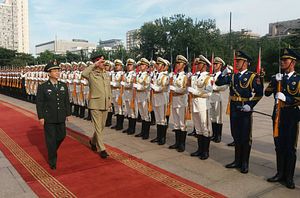General Fang Fenghui, member of China’s Central Military Commission (CMC) and chief of the Joint Staff Department under the CMC, and General Zubair Mahmood Hayat, Pakistani chairman of the Joint Chiefs of Staff Committee (CJCSC), met in Beijing on June 15 to exchange views on international and regional security situations and to discuss deepening military ties between the two countries.
It is the 12th round of defense and security talks held by China and Pakistan, according to Inter Services Public Relations (ISPR), the media arm of the Pakistan Armed Forces. China’s Ministry of Defense reported on Wednesday that the talks “achieved positive results.” Fang noted that “bilateral military relations between the two countries have maintained a healthy and stable development momentum.”
In detail, the general said that the People’s Liberation Army “will promote the development of the Quadrilateral Cooperation and Coordination Mechanism in Counter Terrorism by Afghanistan-China-Pakistan-Tajikistan Armed Forces, elevate the level of cooperation between the two militaries and jointly maintain the security and stable development of the region,” the Chinese defense ministry reports.
Fang also highlighted the “in-depth and pragmatic cooperation in the areas of high-level contacts, joint training, weapons and equipment, [and] anti-terrorism operations.” The Pakistani military and the People’s Liberation Army regularly engage in joint military drills. For example, the People’s Liberation Army Air Force (PLAAF) and Pakistan Air Force (PAF) last held a joint training exercise in April 2016.
Furthermore, the Pakistan Navy held its biannually-held multinational AMAN 2017 naval exercise in February, which included three warships from the People’s Liberation Army Navy (PLAN). In October 2016, the Pakistan Army and People’s Liberation Army (PLA) also conducted a two-week long joint counterterrorism/special operations forces exercise, dubbed YOUYI-VI 2016.
China and Pakistan have also been jointly been developing the Pakistan Aeronautical Complex/Chengdu Aerospace Corporation (PAC/CAC) JF-17 Thunder combat aircraft. The PAF plans to induct 150 JF-17 combat aircraft in the coming years, split into three production blocks. Pakistan produces 58 percent of the airframe and China 42 percent. The JF-17 was specifically developed to replace the PAF’s Dassault Mirage III/5 fighter jets by 2o20.
China is also supporting Pakistan’s ballistic missile program.
Moreover, in 2016, China Shipbuilding Trading Company (CSTC) and Karachi Shipyard & Engineering Works (KSEW) concluded an agreement for the construction of six new maritime patrol vessels for the Pakistan Maritime Security Agency (PMSA) with four ships to be built in China and the remaining two in Pakistan.
China also agreed to sell Pakistan eight modified diesel-electric attack submarines by 2028, although it remains unclear what type of boats will be delivered. “The majority of analysts speculate that the new submarine will be a lighter export version of the People Liberation Army Navy (PLAN)’s Type 039 and Type 041 Yuan-class conventional attack submarine, excluding the sub’s AIP [air-independent propulsion] system, which might be procured independently,” I explained in August 2016.
Fang also underlined that both countries will jointly safeguard the security of the China-Pakistan Economic Corridor (CPEC). Already in February 2016, Pakistan announced that it will create special force of 10,000 troops to protect Chinese workers and industries along the CPEC. China is slated to invest $46 billion in Pakistan in the coming years in various sectors of the Pakistani economy.

































